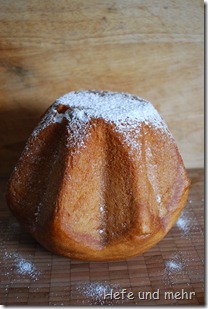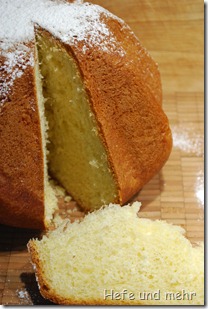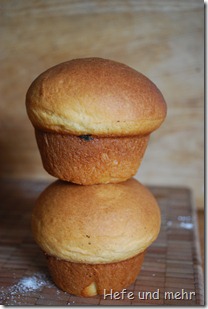
I tasted Pandoro three years ago when a colleague brought some after visiting her parents in Italy. I fell in love with this rich bread with the feather light crumb immediately. After some Internet search I found a Pandoro recipe from the Simili sisters on Chili und Ciabatta . Its a great recipe I made many times since this day. It is a time consuming recipe but the result is worth every second you spend in kitchen.
And the I saw a sourdough pandoro on Wild Yeast and I knew that this is the bread I have to bake for Christmas.
This pandoro is made with a sweet starter, a sourdough that is feed more frequently for two days to enhance yeast growth. My lovely boyfriend had to do babysitting my sourdough and feed it every four hours while I was working. He did a great job and the starter was vigorous rising after every feeding. On the 23. December I did the dough and the bread rose overnight. My pandoro need about 18 hours to reach the top of the pan and I let it rise the last 4 hours on 30°C!
Because I own just one pandoro pan (or more correctly because my mom owns only one 😉 ) I used the remaining dough to fill my muffin pan with mini pandoros.
This Mini-Pandoros we had on 24.December for breakfast, what a delicious treat for breakfast!
Because the dough contains a high amount of sugar and butter, you should keep some details in mind:
Sugar and butter inhibit gluten development. Thats the reason why he sugar is added gradually and the butter is added at the end.
If you can get Osmotolerant yeast its recommended to use it. Its a special yeast strain that can cope the osmotic stress which is due to the high sugar cocentration better as normal yeast. I never saw it in Germany so I use normal fresh yeast in a slightly higher amount.
Pandoro
yield 1 Pandoro a 650g and about 8 small one a 50g
First dough
- 66 g flour Type 550
- 33 g water
- 27 g egg
- 17 g sugar
- 96 g sweet starter, 4 hours after last feedings
Second dough
- 40 g flour Type 550
- 2,5 g fresh yeast
- 27 g egg
- 8 g butter
Third dough
- 60 g flour Type 550
- 26 g egg
- 12 g sugar
- 3 g soft butter
- all of the first dough
- all of the second dough
Final Dough
- 166 g butter (roomtempeature)
- seeds scraped from 1/2 vanilla bean
- 220 g flour Type 550
- 5 g salt
- all of the third dough
- 166 g egg
- 110 g sugar
First dough: Mix all ingredients to form a homogenous dough. Ferment for 2 hours at 30°C.
Second dough: 30 min after mixing the first dough, mix the all ingredients for the second dough and ferment the second dough 1,5 hours at 30°C.
Third dough: Mix first and second dough with the other ingredients for the third dough and ferment it for 3 hours at 30°C.
Final dough: Cream butter with vanilla seeds and set aside. In a stand mixer mix the third dough with flour, salt and 86g egg and knead for 5 min at slow speed. The dough is very stiff at this time.
Now add 30g sugar and mix on slow speed until it is incorporated into the dough, then knead another 4 min on medium speed.
Add 20g egg and mix in medium speed until it is completely incorporated into the dough and a minute longer.
Add 20g sugar and continue mixing until its completely incorporated and a minute longer.
Add now egg and sugar like before until all sugar and egg is incorporated.
Continue mixing on medium speed until full gluten development (about 10 min).
Now turn the mixer to slow speed then add the butter all at one and knead until full incorporated.
Ferment for 2 hours, fold the dough one time in between.
Grease the pandoro pan and the muffin pan.
Divide the dough it into a pieces of 650 g and the remaining dough into pieces of 50g . Shape the dough into tight balls. Place the balls, seam side down, in the pans and proof for 14-18 hours until it reach the top of the pan.
Bake at 175°C for 35 min with steam
Die ist mein Beitrag für Susans wöchentliches Yeastspotting.
Deutsch



Sehr ausführliches Rezept, vielen Dank dafür. Eine Frage: Welchem Zweck dienen der erste und zweite Teig? In beiden ist ja ähnliches drin.
@Hans: Der erste Teig dient dazu, den süßen Starter aufzubauen, der zweite Teig ist ein Hefe-Vorteig. Wenn man alles direkt zusammenrühren würde, würden die Bäckerhefe die Hefen und Bakterien im süßen Starter dominieren und das Aroma würde darunter leiden.
OK, vielen Dank.
Pingback: Pandoro (reine Sauerteigvariante) | Hefe und mehr
Pingback: Hefe und mehr » Blog Archive » Sauerteigbrot mit gerösteten Haferflocken
Nach langem überlegen habe ich es doch noch, das göttliche Pandoro gebacken. Vielen Dank für das tolle Rezept.
Einfach wunderbar.
@Rena: Es freut mich, dass der Pandoro geschmeckt hat! Bei mir steht er auch noch auf der Backliste für Silvester.
Pingback: BBD #25 Baking under the tree – Sourdough Pandoro « * Chaosqueen's Kitchen *
Pingback: Hefe und mehr » Blog Archive » Rosinensauerteig
Pingback: Reisen Billiger Finden
Pingback: YeastSpotting January 1, 2010 | Wild Yeast
@ Laura: Thank you! I think a dairy free pandoro should be no problem. I would use a good margarine instead of butter because I think that using oil like in a challah could make the dough to soft.
Pingback: Ein Festtags Pandoro | Rekas Blog
Great looking pandoro, Stefanie! I really must make this bread (and I want to try to make it dairy-free like challah). And I love the little muffin sized pandoros.
Ich habe meinen Pandoro heute morgen gebacken und die Pandörchen haben wir auch schon probiert. Ich bin total begeistert, der Aufwand hat sich wirklich gelohnt. Das mit der Colomba ist ein super Tipp!
Ich habe allerdings den Zeitplan etwas abgeändert, so dass es für mich besser gepasst hat. Die Zubereitung klappt aber wirklich nur, wenn man ein paar Tage frei hat.
Die Eier habe ich auch verquirlt und dann abgewogen,anders wäre es ja kaum möglich. Deinen Tipp habe ich allerdings erst eben gelesen.
Pingback: Hefe und mehr » Blog Archive » Jahresrückblick 2009
@Chaosqueen: Der Pandoro schmeckt auch nach Weihnachten lecker 😀 (und zu Ostern kann man ihn als Colomba tarnen) Ich habe insgesamt 5 Eier der Größe M verwendet. Wenn man sie verquirlt, kann man Teilmengen ganz gut abmessen.
@ Mama: Danke!
@ Susan: Thank you and a happy new year to you to!
This pandoro looks perfect, Stefanie, as light as can be. Happy New Year!
Mein lieber Schatz,
Als ich über die Feiertage deinen Pandoro genießen durfte war mir schon klar dass ich etwas ganz Besonderes esse. So luftig, leicht und süß. Ein Traum der auf der Zunge schmilzt. Beim lesen der Backanleitung wurde mir allerdings ganz schwindlig. So viel Pflegearbeit!
Aber wir werden besser mit jedem Versuch und so werde ich mich jetzt gleich an die Pflege heranwagen. Genießt euren Kurzurlaub und mit etwas Glück könnt ihr nach der Heimkehr meinen Pandoro genießen.
Auch wenn Weihnachten schon fast vorbei ist, werde ich mich wohl noch an das Nachbacken machen. Besonders die Angabe der Eimengen in Gramm faszinieren mich…
Leider kann ich erst am Dienstag damit beginnen, weil noch ein Familienbesuch ansteht.
Pingback: Hefe und mehr » Blog Archive » Süßer Starter (Sweet Starter)